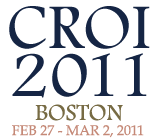 HIV-positive men ages 50 and older are more likely to have symptoms of frailty than HIV-negative men of the same age, according to a study presented Monday, February 28, at the 18th Conference on Retroviruses and Opportunistic Infections (CROI) in Boston.
HIV-positive men ages 50 and older are more likely to have symptoms of frailty than HIV-negative men of the same age, according to a study presented Monday, February 28, at the 18th Conference on Retroviruses and Opportunistic Infections (CROI) in Boston.
In recent years, researchers have identified a cluster of symptoms that when taken together indicate a significant increased risk for illness and death in older individuals. Called a “frailty phenotype,” it is defined as having a cluster of several symptoms that include unintentional weight loss of 10 or more pounds in the previous year, slower walking speed, fatigue, reduced grip strength and low physical activity. People with a frailty phenotype are more prone to falls and find it much more difficult to recover from serious illnesses.
As scientists focus more and more on the issue of aging—and the possibility of accelerated aging in people with HIV—one way they examine the subject is by looking at the incidence of frailty in people with HIV compared with similar HIV-negative individuals. Joseph Margolick, MD, PhD, from Johns Hopkins University in Baltimore, and his colleagues set out to do just that.
Margolick’s team examined data collected as part of the Multicenter AIDS Cohort Study (MACS), which for more than 20 years has been tracking HIV-negative and HIV-positive men who have sex with men. Nearly 3,000 men were included in the analysis, including 1,451 HIV-negative men, 1,307 HIV-positive men taking antiretroviral (ARV) therapy, and 92 HIV-positive men not on ARVs. Among the HIV-positive men, the average CD4 count was over 500, and the majority had virus levels under 50 copies.
Overall, Margolick and his colleagues found that frailty could be detected in 9 percent of HIV-negative men, 8.7 percent of HIV-positive men not taking ARVs and 12 percent of men taking ARVs. When the team stratified the participants by age, they found that HIV-positive men 49 and younger were no more likely to have the frailty phenotype than HIV-negative men. In men 50 and older, however, the difference was significant, with HIV-positive men between the ages of 50 and 69 being about twice as likely to have frailty as HIV-negative men of the same age. These results held steady even in men with viral loads under 50.
CD4 counts were also a significant factor, and the lower the CD4 count the greater the likelihood of having the frailty phenotype. Men with the lowest CD4 counts were about twice as likely to have frailty symptoms. Men with CD4 counts in the 351 to 500 range were 1.6 times as likely to be diagnosed with the frailty phenotype. However, men with the highest CD4s (500 and over) were no more likely to be frail than their HIV-negative counterparts.
“This finding suggests an effect of either HIV infection or [ARVs], or both, on the risk of frailty and perhaps on the aging process,” the authors conclude. “Longitudinal studies are needed to confirm this earlier occurrence, and to determine if the frailty phenotype presages adverse outcomes in HIV-positive people.”
Advertisement
Advertisement
Advertisement






Comments
Comments